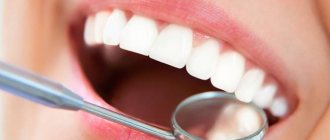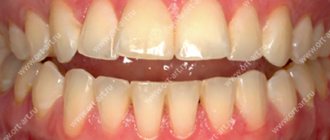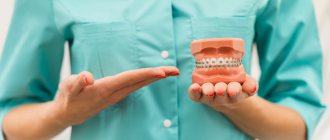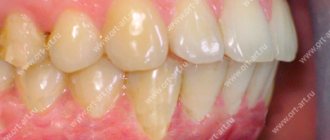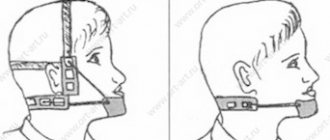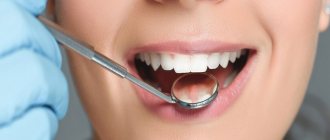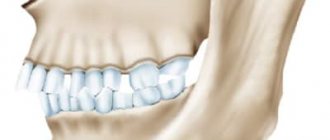Let us pay attention to a problem that is relevant for almost 80% of Russians. Let's figure out how to correct a malocclusion in an adult, because straightening teeth is quite possible not only in childhood. We need to look at the effective ways in which orthodontists make their patients' smiles beautiful and healthy.
We will try to pay maximum attention to the features and differences of the methods so that, if necessary, you can choose the most suitable one for yourself. And be prepared for the fact that the final decision will still have to be made together with the doctor. Because the type of intervention and program of procedures depend on the nature of the pathology, and only a specialist can accurately diagnose its degree and adequately assess the chances of success.
Types of malocclusion
- open - the teeth either do not close at all, or a significant gap is visible between many of them;
- deep – the exact opposite situation, that is, there is an overlap of approximately half the length;
- mesial – the lower jaw, compared to the upper, is moved forward;
- distal – the problem is the opposite of the previous one;
- cross - the right and left sides protrude unevenly, the cutting edges close together.
Other anomalies include:
- diastema - a gap between the front pair of incisors;
- three - noticeable gaps between “neighbors” along the gum;
- twisting - creeping of sixes, fours, fives onto each other;
- transposition - eruption in the wrong places, right up to the palate.
Any of them is not just inconvenient or bad from an aesthetic point of view, but can also provoke the emergence and development of a number of diseases. It develops against the background of genetic abnormalities and heredity, appears due to injuries and loss of bone tissue.
Artistic restoration
Frontal teeth are those elements of the row that are more often than others susceptible to various chips due to injuries, falls, and mechanical effects on the jaw. They are destroyed due to biting hard food, various bad and destructive habits (for example, smoking, biting threads, holding pens and pencils in the mouth).
If cracks and chips are accompanied by an unsightly shade of enamel, the presence of spots, and you are not entirely satisfied with the shape and size of your teeth, then you can make an appointment with a doctor for restoration using composite and photopolymer materials.
The photo shows artistic restoration of teeth
This method is considered the least invasive and inexpensive, and the patient always has the opportunity to change/remake/replace the old restoration with a new one. However, the technology also has one significant drawback: composite materials quickly absorb dyes, lose their shine and become rough, and in order to maintain the aesthetics of your smile, you will have to visit the dentist once every 3-4 months to polish the materials.
Read an article on the topic about the TOP 10 clinics for aesthetic restoration.
Signs of correct bite
Normally, the jaws make close contact when closing. In this case, the upper teeth cover the lower ones by about a third, so that the palatal tubercles of the former touch the incisors of the latter. There are no gaps between them both when the mouth is closed and during chewing. The facial proportions are symmetrical.
Also among the characteristic features:
- absence of speech defects;
- no clicking or other similar discomfort in the joint;
- ease of biting food.
And vice versa, if problems are observed in any of the points just listed, this is an alarm bell and a reason to consult an orthodontist, and immediately, without waiting for the situation to worsen.
Professional oral hygiene
This method is for those who want to preserve the natural health and beauty of their teeth, but at the same time want to get rid of yellow bacterial plaque and pigment caused by smoking or eating food and drinks with dyes, which undoubtedly spoils the aesthetics of a smile.
The frontal units, more often than not, are covered with an unpleasant pigmented coating, and this happens for the reason that they take the main “blow” when we eat, drink, or smoke.
Professional oral hygiene will help preserve the natural health and beauty of teeth
Professional hygiene, which includes ultrasonic cleaning and the use of an Air Flow device, will help remove all types of plaque and make the teeth in the oral cavity (both frontal and chewing) clean, well-groomed, smooth and shiny. The procedure will return the enamel to its natural shade and will also be an excellent prevention of dental diseases.
“Friends, I recently completely transformed my smile, and my epic treatment with the orthodontist has come to an end! I wore braces for two and a half years, and after they were removed, it was discovered that the front enamel was covered with white spots... This was very frightening and upsetting at first. One front tooth on the upper jaw stood out especially strongly; it was generally dark... But my orthodontist signed me up for professional cleaning and assured me that it would all go away. Indeed, I went to the hygienist, they did some magic and applied a strengthener with fluoride. Afterwards, the enamel became clean and smooth, many spots faded! Hooray! I accept congratulations!”
Yana D., fragment of a review from the site Irecommend.ru
Why you need to straighten your teeth
Please note that the question is not whether it is worth correcting the bite - it simply needs to be done, and for several reasons:
- To avoid increased abrasion, caries, removal - when everything is normal, all incisors are evenly used when chewing, and in case of disturbances, some work more, others less; The former lose enamel faster and chip, the latter are less resistant to bacteria.
- To prevent diseases of the temporomandibular joints as a result of their mutual displacement. This pathology is also unpleasant due to bruxism, muscle spasms, clicking and crunching.
- To protect the gums, tongue and inner cheeks from injury caused by out-turned or tilted incisors.
- In order to grind food well during eating, not to create additional stress on the gastrointestinal tract and not to provoke problems with stool, enterocolitis, gastritis.
- To prevent problems with ENT organs and breathing, eliminate the source of bacterial accumulation and not give a single chance to sore throat, sinusitis, and otitis media.
People who have experienced complexes about their chin and then decided to have surgery or wear braces can tell a lot about whether to correct their bite. After medical help, they are much more willing to show their smile when communicating.
Enamel remineralization
If small cracks and white chalky spots appear, indicating demineralization of the enamel, hypoplasia and fluorosis are present, then remineralization procedures in dentistry will help correct the situation in combination with other measures and prevent its aggravation, when doctors apply products with a rich mineral composition to the enamel, where includes calcium, magnesium, fluorine. At home, you can also additionally use remineralizing pastes and gels, for example, Tooth Mousse. Overall, this measure will help improve the appearance of your smile.
Fluoridation will help strengthen tooth enamel
Diagnosis of anomalies
There are obvious cases, such as a pronounced diastema or torsion, you can notice them yourself when standing in front of a mirror. But there are also minor disorders that are no less dangerous to health, and only a specialized doctor can identify them.
Usually, hidden defects are easily recognized by a dentist - when he conducts a preventive examination, removes plaque or places a filling. Then he describes the problem and gives a referral to an orthodontist, who will determine how to straighten the jaw, bite, and a couple of adjacent teeth. To do this, a specialist will conduct a thorough examination of the patient’s mouth with a computed tomography or x-ray.
The anomaly can also occur during life, for example, after injury. Therefore, it makes sense to visit a doctor regularly, every six months, so that he either confirms that everything is in order, or promptly notices unwanted changes, which are easier to stop at the initial stage.
Wearing orthodontic systems
Among modern society, such a pathology of occlusion as crowding is very common. This defect is most often characteristic of those elements of the row that are located in the frontal zone. The situation can be corrected with braces. If you want your smile to be as attractive as possible during correction, then it is better to choose ceramic or sapphire models, or completely invisible lingual ones (attached to the inside of the row).
Braces can help correct crooked teeth
Another aesthetic option is wearing aligners. These devices are removable, transparent and more comfortable than braces. True, their cost is higher, and they cannot cope with severe bite pathologies.
Abnormal alignment and curvature of the anterior units can also be corrected with other removable orthodontic appliances, such as plates and trainers.
Up to what age is correction possible?
For many decades it was believed that the impact would be successful only in childhood, and during primary and secondary school, and not later. But with the development of orthodontics, things have changed. Today, achieving a healthy smile is not difficult at any stage of life - the main thing is that the person himself wants it, so that he is ready to patiently follow a number of medical prescriptions.
What is the problem with correcting bites in adults?
A child's jaw is in the process of growing, so it is more flexible and easier to change. At the age of 15, this is generally easiest to do: the incisors move relatively easily, they are fixed more securely - you have to wear braces for a year, no longer.
For a mature person, a similar procedure will take from 2 to 3 years, because his bone tissue is already formed. It is impossible to expand the space between the teeth, to move them apart; there is simply no free space. In some cases, you even have to remove, say, completely healthy eights.
Another nuance is that, say, at the age of 30, you will also need to consolidate the achieved result, and it will take a long time - from 20 to 40 months. Sometimes people wear retainer structures for almost the rest of their lives. This is explained by the fact that the incisors have already become “accustomed” to their positions and tend to take them again after the braces are removed.
How to choose a good doctor
With a large number of offers of dental services in Moscow, it is difficult to make a choice where and in what way to straighten teeth without braces for adult patients. The reputation of the clinic, the equipment used, the quality of the materials used, and the qualifications of the doctors are of great importance.
First of all, pay attention to the following factors:
- extensive practical experience, working with similar clinical cases, certificates;
- conducting a thorough preliminary examination and competent recommendations;
- availability of modern computer technologies for treatment planning;
- positive reviews online and in the professional environment, recommendations from other patients;
- working with high-quality materials and manufacturers of orthodontic products with an impeccable reputation.
In most cases, orthodontic services are quite expensive. Saving on treatment costs can adversely affect the final result and lead to complications. At the Federal Scientific and Clinical Center of the Federal Medical and Biological Agency of Russia, you can straighten your teeth under optimal conditions, without compromising the quality of work.
Who are aligners suitable for?
In their work, the clinic’s doctors use aligners from the American company Invisalign. They are made of safe polymer and are absolutely safe for the body. The mouthguards are comfortable to wear and effective. The results of Invisalign treatment are comparable to the use of braces. They cope with all malocclusions. Aligners are installed for all patients, regardless of how old the patient is.
The main rule for successful treatment is to wear a mouthguard at least 20 hours a day. Propricus dentistry has everything you need to carry out orthodontic treatment by any method.
Options for children
Malocclusion in a child can manifest itself from the moment the first milk teeth erupt or during the period of age-related changes in permanent ones. But you can resort to bite correction with braces only after the final formation of the dentition, at about 14–16 years.
Until the required age is reached, other methods of straightening children's teeth without the use of braces are used.
These include:
- orthodontic plates;
- mouthguards-trainers;
- myogymnastics.
In some cases, it is possible to completely correct bite defects, in others, preventive measures help slow down the development of pathology and wait until it is possible to install braces without the development of complications.
Orthodontic plates
Plates
allow you to adjust the position of your teeth by widening or narrowing your jaws. They are silicone or plastic overlays on the palate or sublingual space. The force on the teeth is exerted using metal arches, springs and screws.
Removable orthodontic plate
There are removable and non-removable structures. The latter are securely fixed to the teeth with a system of locks and are capable of correcting severe defects. Removable ones are more convenient to use, they are attached with hooks, and allow the child to independently remove and install the device for eating or performing hygiene procedures.
Fixed orthodontic plate
Parents are often interested in whether it is possible to straighten teeth with a plate. For uncomplicated bite pathologies, timely installation of devices helps to completely solve the problem or prevent complications.
Pros:
- the method is used in early childhood, when other methods are not available;
- the ability to choose colors according to the child’s wishes;
- independent adjustment of the width of the plate using a special screw;
- short-term use (for removable plates).
Despite the impressive size of the device, the adaptation period passes quickly.
Minuses:
- injure the mucous membrane, causing stomatitis and inflammation;
- temporarily impair diction;
- noticeable to others;
- require constant wearing (for fixed structures).
The period of use of the plates is up to 2 years.
Price:
from 7 thousand rubles (depending on the complexity of the device), the cost of individual models reaches several tens of thousands.
Trainers for teeth
Trainers for teeth
- These are orthodontic aligners made of silicone or polyurethane. Dress for the night.
Trainers for teeth
The method of action is similar to aligners: linings of varying hardness - soft in the initial period and more elastic in the subsequent period - straighten the teeth into the correct position using light pressure. These devices are also used to consolidate the effect after wearing plates or braces.
Regular use of dental trainers relieves uncharacteristic muscle strain and normalizes natural nasal breathing, which, in turn, prevents the further development of pathology.
Even if it is not possible to straighten your teeth with trainers, they are a good way to prevent complications before installing braces.
How to wear trainers.
Mouthguards are installed on the upper and lower jaws simultaneously at night and for 2 hours during the day. During this period, you cannot talk or eat.
Fixation steps:
- Place the trainer in your mouth with the “marker” facing up.
- Touching the “marker” with the tip of your tongue, it is easy to clench your teeth, placing them inside the mouthguard.
- Close your teeth and lips tightly, breathe through your nose.
Difficulties may arise in the first days of use, then the process of installing the mouth guard occurs automatically.
Indications for using the trainer:
- mild pathologies;
- breathing, swallowing, diction problems;
- anomalies in the formation of the lower jaw, crooked teeth;
- presence of bad habits.
Also, wearing a mouth guard is indicated during the rehabilitation period after using plates and braces.
Contraindications:
- difficulty breathing, displacement of the nasal septum;
- severe malocclusion pathologies, including deep lateral bite.
Pros:
- are not visible to others, as they are used at night - during sleep;
- removable design – trainers can be easily removed without outside help;
- easy to use and maintain;
- low cost.
Minuses:
- low efficiency;
- must be removed while eating and communicating;
- impossible to securely fix during sleep (may fall out).
Price.
Trainers are popular due to their low cost. Universal sizes allow you to select a mouth guard according to the patient’s age and do not require individual manufacturing. The price of the device is from 2500 rubles.
Is it possible to straighten teeth with trainers? Unfortunately, serious malocclusion pathologies cannot be corrected with the help of these devices.
Preventive myogymnastics
An affordable way to prevent the development of bite pathologies is to perform special exercises aimed at developing the jaw muscles.
Myogymnastics in orthodontics
The use of myogymnastics in orthodontics helps speed up the process of bite alignment.
Types of exercises:
- for chewing muscles - with a deep bite;
- for the muscles responsible for the mobility of the lower jaw - with a distal bite;
- for circular muscles – with mesial occlusion, tremors, non-occlusion;
- for the tongue - stretching the frenulum.
Systematic implementation of myogymnastics in combination with hardware methods makes it possible to more effectively eliminate mild malocclusion pathologies in children.
And if there are no front teeth, how can you transform your smile?
The absence of front teeth is a strong blow to pride. With such a problem, a person withdraws into himself. Situations where the front element of a row could not be saved are not uncommon. What to do then? There are several options to solve the problem:
- implantation: it is better if the situation allows for the immediate installation of an implant simultaneously with tooth extraction - this solution will help avoid complications in the future (for example, bone tissue atrophy and the need to build it up) and will shorten the treatment time. If a tooth in the upper jaw is being restored, then after its removal and implantation, it will be possible to immediately install a lightweight crown removed from the bite. However, this is only possible in a favorable clinical situation, when the implant has high initial stability,
Implantation is a good solution for tooth loss
For restorations in the smile area, it is better to choose high-quality implant models that promote long-term preservation of aesthetics and prevent subsidence of the marginal bone at the border with the gum. For example, the brands Straumann and Nobel can boast of this.
- prosthetic bridges: for anterior units, adhesive bridges can be considered as a temporary solution, the installation of which does not require trauma to the supporting elements. Or classic bridge structures as a more durable option, but requiring depulpation and strong preparation of the “supports”,
- wearing removable structures: for example, temporary immediate prosthesis “butterfly”. However, for frontal teeth this solution cannot be called a good one, since the bone tissue of the jaw quickly sags under the removable systems, as a result of which the aesthetics of the smile is disrupted, and the structures themselves begin to move, shift, rub the mucous membrane and fall out.
As you can see, there are a lot of options for transforming your smile. All that remains is to make an appointment with a doctor. The specialist will select a method according to your clinical situation and financial capabilities.
Notice
: Undefined variable: post_id in
/home/c/ch75405/public_html/wp-content/themes/UltraSmile/single-item.php
on line
45 Notice
: Undefined variable: full in
/home/c/ch75405/public_html/wp-content /themes/UltraSmile/single-item.php
on line
46
Rate this article:
( 4 ratings, average: 5.00 out of 5)
whitening
- Chernyavsky Yu.P. Prevalence of aesthetic disorders of the frontal groups of teeth // Bulletin of Vitebsk State Medical University. – 2003.
Expert “Due to anatomical features, the anterior units are more fragile, they are susceptible to pigmentation, and are more quickly destroyed by caries and other dental diseases than chewing ones. They are the first to suffer in falls, accidents and various impacts. They are susceptible to demineralization and the formation of white chalky spots (for example, after wearing braces). In all of these cases, patients are thinking about how to transform their smile, and modern dentists are ready to offer a large number of methods to solve the problem.” Dentist-therapist Tatyana Vitalievna Varlamova
Consulting specialist
Dzhutova Aida Vladimirovna
Doctor rating: 8.8 out of 10 (5) Specialization: Implant surgeon, periodontist Experience: 10 years
Stock
-47%
Dental implant Osstem 35,000 rub.
18500 rub.
get -20 %
Manufacturing of removable denture Acry Free 40,000 rub.
32,000 rub.
get -9 %
BASAL COMPLEX - Restoration of teeth on 1 jaw in 3 days 330,000 rub.
300,000 rub.
get -19 %
German implants XIVE Friadent 80,000 rub.
65,000 rub. get
